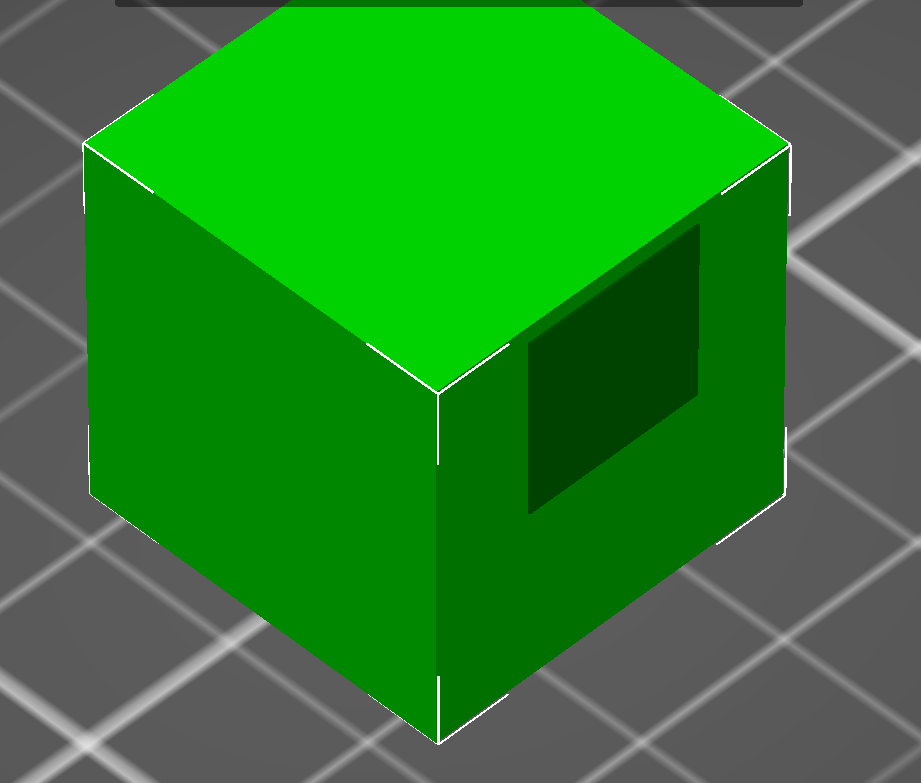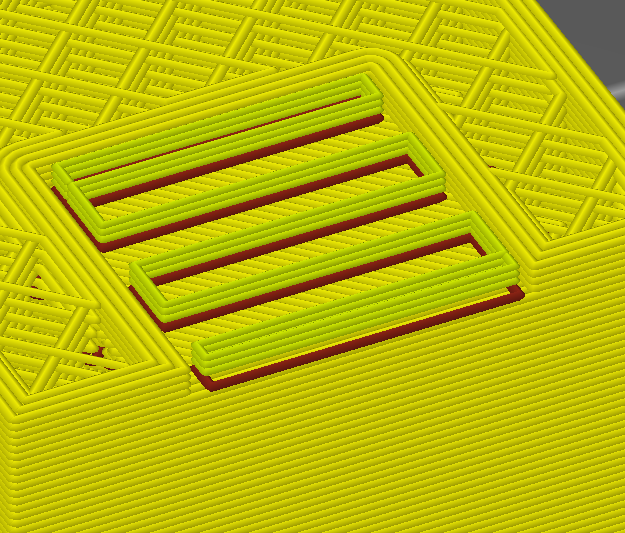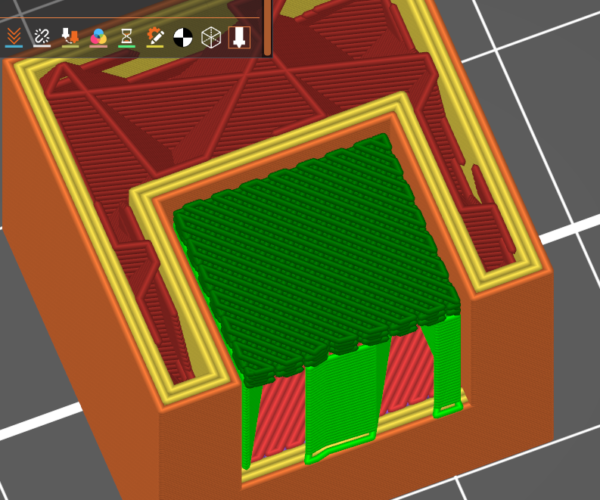Snug supports slightly overhang model edge leading to print issues
I'm extremely impressed and pleased with PrusaSlicer! I have recently run across a condition that I have been unable to isolate, and am curious if this is a known item or if I may have overlooked a setting that applies. I'm using version 2.8.0+win64. I created a simple model in PS with a box that has a smaller negative volume box embedded in the side to create a cutout that will be supported.
What I'm noticing is that when using "snug" supports with supports "Everywhere" and with the default "Bottom interface layers" of 0, the 1st layer of the support built ON-TOP-OF the model overhangs the edge of the model, which causes it to be unsupported and droop like a wet noodle when actually printed. As a result, several layers of the support are gnarly, but it eventually evens out and the model printed none-the-worse-for-wear with the exception of the first couple centimeters of support layer. While it can certainly be lived with since it only seems to mess up a little bit of the supports, I'd like to know if there is a setting that will eliminate the issue.
Another clue that I discovered that may reveal a bit more is that if "thick bridges" is enabled, that single line that overhangs is now thickened when viewed in layer height which seems to indicate that PS is treating it like a bridge? (pic below)
Workarounds:
While I haven't found a way to eliminate it, I have found some workarounds that can be used with tradeoffs.
- If a bottom interface layer is added, the interface-itself overhangs, but the support no-longer does (pic below).
- If "grid" supports are used, a support structure is built up from the build plate that the overhang anchors to. Of course, a lot more support material is used this way (pic below).
- "Organic" supports don't exhibit the issue.
The Pics:
Simple model to illustrate issue.

The red arrow indicates the location of the 1st layer support overhang with the Snug overhangs.

Top-down view of same issue.

Settings.
Workaround - adding a non-zero support bottom layer interface thickness.

Workaround - Using Grid supports with same model.

Clue 1 - Snug supports with Thick Bridges enabled is thickened when viewed as sliced "height" which seems to suggest that 1st layer of support is treated as a bridge even though the feature is still identified as support material when viewed as "feature type".

I'm very curious if anyone knows what I'm seeing here.
Thanks!
RE: Snug supports slightly overhang model edge leading to print issues
For future reference the easiest way to show 'your work', settings etc is to post your Prusa slicer project file. File>Save Project as. The 3mf produced will contain the part and all the settings. So we get a snapshot of it that we can examine. You do however have to ZIP up the file for the forum to accept it. If you don't it will just silently not attach anything.
Anyway on to your subject. Yes, that's the way PS works. It always overlaps a bit. Not like the bad old days where we just had grid. where it just grew out to monster size. The way to get around it is never to use supports everywhere. In fact just don't use that. The most efficient way to do supports in PS is to use the option "For Support Enforcers Only" and then use the paint tools to precisely define what surfaces you want supporting. The paint tools are incredibly easy once you figure them out. You can then make sure the very outside edge isn't painted and the support will indent to match. Of course with your example you are using a negative modifier, and unfortunately you can't paint non existent geometry. An excellent example of the limitations of modifiers.
You can also adjust the Support pattern spacing depending on the model too. Also change the support angle. That should minimise the extra. Generally its not a problem as without the bottom interface layer it just comes off with the rest of the supports.
As for the thick bridges, that used to be the default, it always did that. Be thankful you can turn it off as an option now. It took literally years of us asking on github for that to be optional. With it on the thickness of the layer on your part above supports is basically your nozzle diameter, no matter what your layer height is configured as. The theory was that as you are printing in mid air with no 'squish' the filament is always going to be the nozzle diameter. Which is fine as a theory. When Super Slicer allowed you to change it and we could print without that setting and could prove that prints looked better the request for PS to change that default logic got more traction.
We used to get that question all the time. Why is the layer on the bottom of bridges so thick, ah the good old days. You wouldn't believe how many github bug reports used to put in about that and then closed.
What sucks is it still automatically applies it to bridge infill no matter what you do which can cause issues if your geometry is too thin for many layers on top of infill.
RE: Snug supports slightly overhang model edge leading to print issues
@neophyl Thank you for your reply. As you mentioned, I did attempt to upload the .3mf file with my post, but you provided the critical nugget that explains why it wasn't an accepted filetype -- that I needed to zip it up. I'll know better next time.
Thank for your confirmation that what I am seeing is just the way it is -- that I'm not missing a specific setting that controls that on automatic supports in "Everywhere" mode. I'll certainly keep your suggestions in mind with regard to avoiding "Everywhere" mode whenever possible and using support enforcers/blockers. It is interesting hearing the historical perspective you have of how these features and others were added and evolved over time.
I appreciate you taking your time to answer my post -- I feel like I've learned something. Have a nice day.

